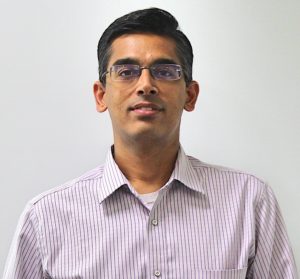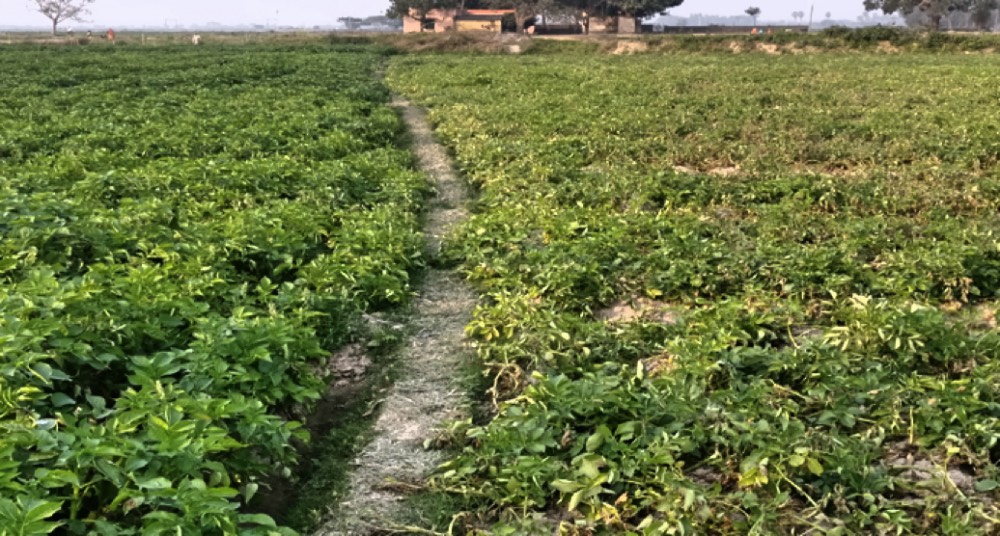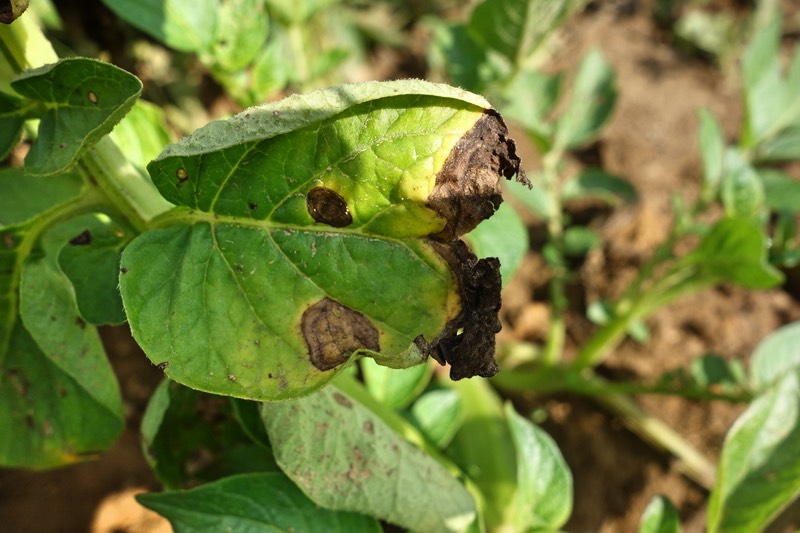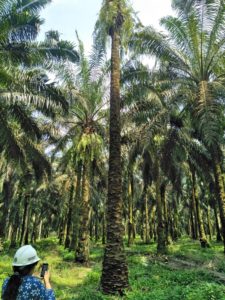India has the second largest (157.35 million hectares) agricultural land in the world. Agriculture is the primary source of livelihood for approximately 58% of India’s population but accounts for under 15% of GDP. Increasing agricultural productivity is the key to raising the GDP growth in India, as well as lifting millions of people out of poverty.
On average the Indian farmer holds land with an area of 1 hectare or less. The farmer has four fundamental challenges:
- To increase productivity to be more in line with regional / world averages.
- Get a decent monetisation of crop output (market access, fair price, minimum support prices (MSPs), export markets, urban consumption).
- Reduce risks/volatility in production (dependence on monsoon, financial risks due to volatile costs/prices, and extreme event risks).
- Insufficient or no access to capital.
These challenges cannot be solved through technology and data insights alone as it involves policy, policymakers, government, markets, the supply chain, and various stakeholders in the chain who get the crop from field to market and into the hands of the consumer.
However, scientists and researchers at IBM Research India have conducted pilot trials to show that the use of remote sensing technology, combined with artificial intelligence and blockchain can solve some of the challenges outlined above, at scale.
Helping Farmers Increase Crop Yield
IBM Research India combined AI with remote sensing to drive insights for agri. Since remote sensing data is widely available, it can use AI at scale.

Sriram Raghavan, Vice President-AI, IBM Research
“We have the opportunity to get deep insights about a farm, without the need to rely on deep on-ground instrumentation,” said Sriram Raghavan, Vice President-AI, IBM Research. You can use on-ground instrumentation selectively only to do some validation. But you can do quite a bit using AI and remote sensing data.”
IBM researchers combined multiple global satellite-based information sources to compute actionable agronomic insights (such as crop health stress alert, water stress, pest/disease risk forecast), for individual farmers at a sub-acre level. Then IBM Research’s big data platform called PAIRS – Geoscope (Physical Analytics Integrated Data Repository and Services) is used to ingest, curate, and manage the big data, and build analytical layers.
“PAIRS is a platform for managing and curating vast amounts of satellite data and doing AI on it. It consistently curates 15 – 20 petabytes of data a day. It supports sophisticated AI on top that allows us to bring together different types of satellite data,” said Raghavan.
IBM can also enhance the quality of the data to overcome cloud-occlusion during the Indian monsoon season, using machine learning techniques to fuse multiple information sources.
“We are providing insights about a farm and built a set of services that you can think of as a ‘Digital Twin’ of a farm. The attributes of interest are: what is happening under the ground (soil moisture), what is happening on the ground (crop health), and what is happening just above the ground, in terms of climatic and atmospheric conditions (weather data),” added Raghavan.
These precision insights can be delivered to low-end smartphones (costing around $50) used by the farmers and agronomists in the fields. Farmers can now tap the rich remote sensing data, and sophisticated output of cognitive analytics to get predictive insight on their farms at the right time, to manage scarce groundwater-based irrigation, optimise the timing/amount of fertilizers & pesticides for the right part of their farm, and time their harvest to maximise produce and minimise wastage.
“Pilots for agri have been done in India, the ASEAN region, Brazil and the US. Within India there are four pilots in Karnataka, Maharashtra, West Bengal, and UP with different use cases, either ongoing or just completed — in the spectrum from precision agriculture to pricing to the insurance space,” informed Raghavan.
The remote sensed data can also be combined with parsimonious locally sensed IoT data (soil moisture sensors, local weather stations) to get even more precise insights. This is called on-ground instrumentation.
IBM also announced its next-generation weather forecasting capability.
“Putting our agri and weather capabilities together, down to the size of land holdings we see in countries like India and other emerging markets, we can offer deep insights,” said Raghavan.

IMAGE CREDIT: IBM Research India
An example where you can clearly see the impact of farm management through remote sensing. Left side of the image shows a controlled field and on the right side is the reference field. In the right side, you can see that the crop got damaged due to a disease attack. It did not happen to the left field as curative spray was done ahead of time.
Beyond Precision Agriculture
So far most of the efforts at IBM Research have been directed at precision agriculture use cases – plant pathology (saving crops from pests or diseases), soil moisture monitoring, and improving yield. Using remote sensing data IBM has contributed heavily to the welfare of farmers in India and ASEAN. But IBM now wants to go beyond that into other areas where the entire supply chain can benefit.
“While IBM has so far focussed on putting together the building blocks for precision agriculture, in 2019 we will focus on commodities and pricing as well as financing and insurance,” said Raghavan.
IBM will use emerging technologies like AI and blockchain for price prediction, crop insurance, financing, and credit scoring.
Here are some use cases.
Price Prediction: To be able to inform one about commodity pricing. If one can accurately estimate yield and acreage under yield, at a fine resolution, while considering the chances of spoilage because of pests or weather, one can improve the yield that enables better commodity trading. It will also enable those in the public sector to understand price fluctuations better.
Financing and Credit: Better insights about yield from the farm can drive better decisions and expectations in insurance, credit and financing.
Crop Insurance: There are three use cases for insurance. One type is providing insights that help in pricing. Usually, insurance companies use historical data to give them a sense of what the yield might be. IBM wants to improve the accuracy of models used by insurers through real-time insights. That will allow them to do better pricing upfront. But it can also inform farmers about risk exposure to their crops, halfway through the season, enabling them to do better financial planning. The third case is claims validation, which takes time since a person on the ground goes to do the validation. They check crop loss, low yield etc. If this validation is done remotely, then that drives down the cost of validation and speeds up the issuance against the claim.
Banks and insurers must rely on historical information to assess the credit. And there are many parameters. The challenge is: a significant portion of the creditworthiness of the people in the ecosystem is driven by the output that they can produce, and the price that they are likely to get for the output. The accuracy of this assessment can be improved in more insights are available about the health of the farmers’ output, and the price of their output. These become parameters to the risk model.
With the rich insights it provides IBM is solving a major challenge for banks as these inputs are not available at scale today.
“While we are not claiming to build a risk model for the bank, we are providing insights that help the bank make better decisions. We are providing insights into their risk model, which is expected yield, price and risk of crop,” said Raghavan.
IBM is also trying to solve a pricing challenge for the farmer to advise where to go to sell the crop, at what price, and what type of crop he should be growing.
“We have not yet started working in this area, but technology innovation can also help here. This challenge will be addressed as we start taking our precision agri work into yield prediction and acreage estimation, which has an impact on pricing,” said Raghavan.

IMAGE CREDIT: IBM
This a potato leaf with early blight infestation. IBM is using Watson Decision platform and advanced image analytics to detect this disease early. Farmers can take a picture of the crop and Watson can detect the disease on the fly.
Blockchain and the Food Supply Chain
The movement of food from the fields to the consumer is complex as it involves numerous transactions between various entities in the supply chain. IBM is trying to simplify the process, to enable transactional information to be shared securely between all stakeholders in the food supply chain. It is using blockchain technology and has created the IBM Food Trust network.
Sharing his views on the relevance of the predictions for the India market Raghavan said, “India as a country faces many challenges across its Food Supply Chain – small fragmented land holdings (many less than a hectare), waste in the food supply chain, and the urgent need to efficiently manage precious resources like land and water while responding to rapidly changing weather conditions. We believe that the digitization of the food supply chain powered by technologies like AI, IoT and Blockchain are critical tools in addressing these challenges and transforming the food ecosystem in India.”
IBM Food Trust aims to create visibility and accountability in the food supply chain. This network connects growers, processors, distributors, and retailers through a permissioned, permanent and shared record of food system data.
“The insights derived from precision agriculture using remote sensing and AI, can now move through the supply chain and inform business processes downstream in the chain,” said Raghavan. “The insights derived could predict the likelihood of a pest attack or crop disease, or the fact that the quality of output may not be high. If my vegetation index is low, then either the output will be low in volume or low in quality. If there is a high instance of pests or crop disease I can estimate the impact of the total crop yield.”
This kind of information is immensely useful to all stakeholders in the supply chain, who can plan, once they receive this information through the IBM Food Trust blockchain network.
There is another use case. A food processor who is procuring vegetables through the supply chain, cleans and cuts these vegetables, puts it into boxes and sends it along to the distributor. The food processor spends on inspection for health and quality control. But this is done on a random sample, and it involves risk. The likelihood of risk of inspection could drive the insight on what to inspect. That is estimated by all the information flowing through the blockchain, starting from the original production, thereby mitigating risk.
“Today IBM Food Trust handles information only from when the food is packaged. But now with the agri capabilities, we can go upstream right up to production, where crops are grown. And we can drive insights such as risk insights, yield. The blockchain network carries it downstream and allows better decision making for logistics providers, food processors, and retailers,” said Raghavan.
That’s why IBM is trying to connect its agri play to blockchain. When the two are linked, deep insights about every aspect of farming can be sent down the supply chain, thus helping all entities to make informed decisions and be better prepared for unexpected results, based on current weather conditions and crop health.

IMAGE CREDIT: IBM Research India
This a palm tree infested with a disease called Ganoderma. This is a very severe disease and there is no curation for this disease. If it isn’t detected early, infestation might spread to the nearby trees, and all of them needs to cut. To stop spreading this disease, IBM is using remote sensing and multi-spectral image analysis to detect Ganoderma at a very early stage.
Also see: From Seed to Shelf: How IBM Innovations Will Transform Every Stage of the Food Supply Chain Within the Next Five Years
Challenges Ahead
While the network carries information and advisories, there could be some challenges on the ground. IBM sees the last mile problem as one of the biggest challenges.
“For the use cases around banks and insurance, you don’t need feet on the ground. You just go with the data and make your decision. But for precision agriculture, you need feet on the ground. And that’s a challenge to do at scale,” said Raghavan.
IBM is responding to this challenge with a two-fold approach. One, it will become a platform enabler for other companies who have connects (and distribution channels) to the farmer. For instance, it is working with startups like RML Agritech, which build on top of the IBM platform. The insights are channelled through them to reach the farmers. In return, they can offer their services and products to the farmers — selling equipment of fertilisers on the IBM platform.
The second approach is to work with enterprises that are already engaged with farmers.
“We don’t own the last mile. They become another channel through which some of these insights can reach the farmers. We are addressing the last mile problem in pockets by working with individual players who have access to farmers,” said Raghavan. “But doing this at scale will require considerable public sector involvement.”
Conclusion
While IBM has the technology to provide and distribute the insights, its model will be successful only with the participation and involvement of all entities in the supply chain.
The insights are certainly going to help farmers, banks, insurers, food processors, retailers and logistics companies to make better decisions, mitigate risks, and save wastage and costs.
But the point to note is that even the most significant challenges can be solved using a combination of technologies and combining data from multiple sources. With AI and Blockchain, this can be done at scale to benefit farmers anywhere in the world.
With inputs from IBM Research India, IBM Blogs and articles









